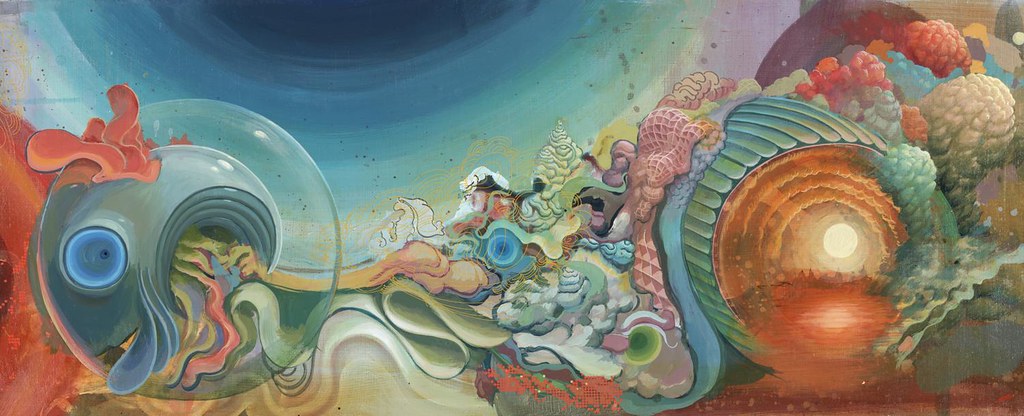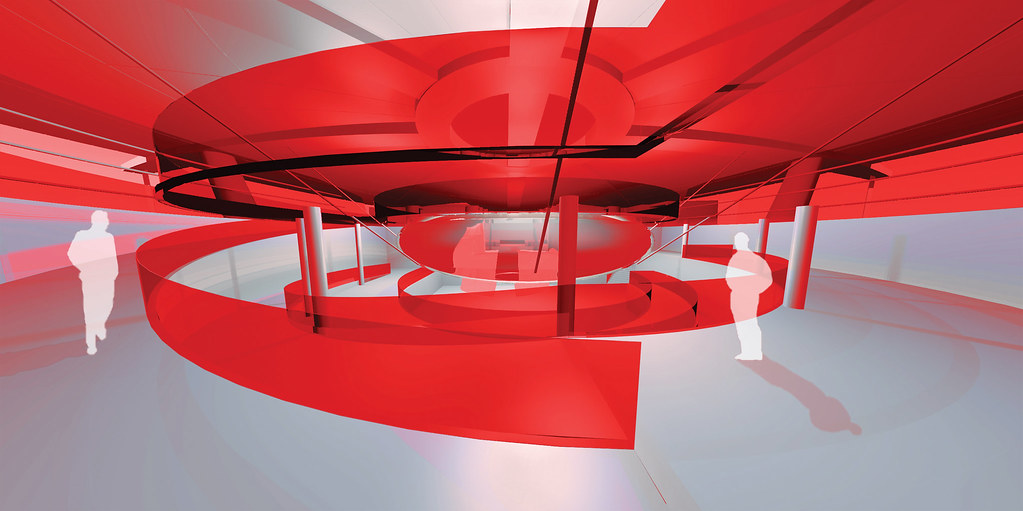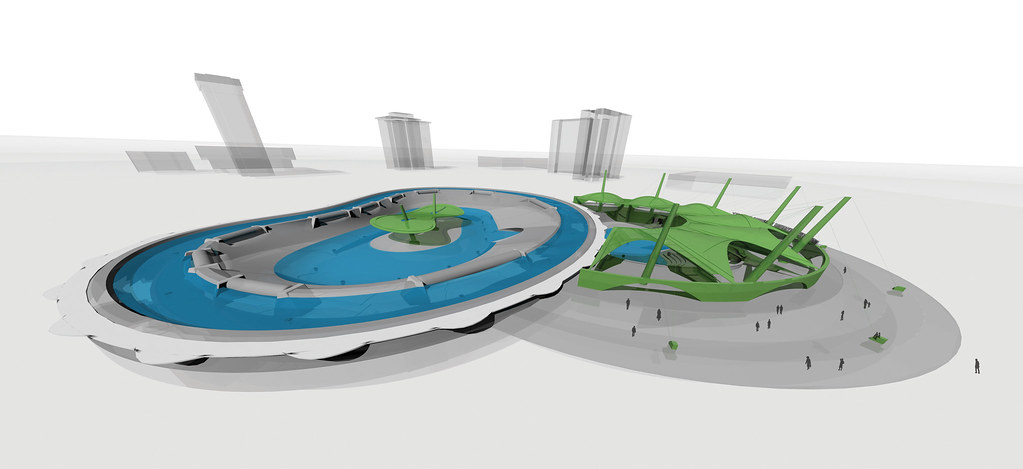28.3.09
Talks James Howard Kunstler: The tragedy of suburbia
James Kunstler puts into words perfectly of how the model for creating cities for the last 60 years has failed us. The lack of clearly understanding the importance of the basic ideas of creating a sense of place within these areas has led us down a path that is almost irreversible. I find it interesting that there seems to be very little solutions to the problem that suburbia has created. He loosly shows the idea of trying to re-urbanize the parking lots of large malls and big box stores. I think that if anything his solution points out that it is possible that there is no solution to re-urbanizing some of these areas.
A longer documentary "The End of Suburbia" starts off with a quote by James Kunstler. It goes into further detail of how this all started and why it will continue to be a path down a dead end street. Here is the link
27.3.09
st. austin's parking facility
 This is the first project I worked on with The Lawrence Group. Week one consisted of late night charrettes to meet the Construction Document submittal. I began drafting details for large 6'x10', center pivot, checker plate steel, doors for two electrical closets. I also drafted plan details for the 2'x2' concrete columns which have pipe inserts to allow steel cable to pulled through as railings/car barriers. Elevations, sections, plans and misc. details were drawings of the facility that I drafted and learned the assemblage of a document set and details regarding the construction of a sick parking facility.
This is the first project I worked on with The Lawrence Group. Week one consisted of late night charrettes to meet the Construction Document submittal. I began drafting details for large 6'x10', center pivot, checker plate steel, doors for two electrical closets. I also drafted plan details for the 2'x2' concrete columns which have pipe inserts to allow steel cable to pulled through as railings/car barriers. Elevations, sections, plans and misc. details were drawings of the facility that I drafted and learned the assemblage of a document set and details regarding the construction of a sick parking facility.
This is a mixed use building with retail wrapping the outer street facades and a split level parking facility, for renting to college students and its congregation, embedded beyond. Cladding the facade are CMU, precast conc. panels, and vertical bent aluminum solar fins and storefront aluminum system with glazing and spandrel panels. The project is located across from UT and falls within the guidelines of the UNO (University Of Texas Neighborhood Ordinance) which exempt it from Subchapter E Design Standards. But, UNO have ordinances about the visibility of the cars in the garage as well as ordinances clearly stating that the garage levels cannot be discernible as a garage (other criteria as well). The lot is tiny which is why we designed the split levels, it allows more cars to fit within the building without it growing taller than the ordinance allows. The project is nearing completion and these pictures were taking during a walk through with the owner group. Overall it was a sink or swim first couple of weeks and an intense and necessary learning experience.
26.3.09
RUSSEL WRIGHT

I don't usually think about my dishes as being something that is designed - silver ware yes. Nor do I spend time contemplating dishes as design objects. However; as I moved into the new 4401 - which is smaller, quaint and older, about 70 years old - my neighbor gifted a couple of cool things. In this collection is a set of WWII era objects, a small set of ceramic dishes. Growing up in the 80's during the plasti-ware boom, ceramic was not common in our house. My grandparents for the most part were post WWII consumers and I was not introduced to designer dish wares. The salad bowls are the coolest little gems - they are a set of mix and match colored salad bowls by Russel Wright. These little bitches are designed in a way in which the hand can take a myriad of positions to hold the bowl - a small lip on the edge of the curve allows the hand different positions to caress, grip, hold, hang, drape, and set the bowl. I used dishes as necessary objects but paid little attention to the detail and care put into their creation. A cup, a bowl, a plate, a saucer, a tea cup, a mug, a pitcher ... analytically the basis of design for each centers on functionality: solutions on how to contain a food/beverage - how to keep these foods hot/cold - the lifetime durability of the object so that the user can reuse it multiple times. What sets these apart from crappy plastic bowls is that while the Wright bowls fulfill the functional obligations they also fulfill an aesthetic and functional need beyond the basis of design. Check out the links regarding Wright - I've noticed a huge draw to 30's and 40's design lately ...
ANGIOGENESIS NETWORKING
 A research project under the direction of LabStudio (Jenny Sabin & Peter Lloyd Jones)
A research project under the direction of LabStudio (Jenny Sabin & Peter Lloyd Jones)By Jeff S Nesbit, Shuni Feng, Joshua Freese;
work shown by JSNesbit
Coordinated endothelial cell networking, a component of angiogenesis, is required to form and refine the exquisite fractal network that emerges in the developing and mature lung to facilitate efficient gas exchange from birth onwards. Real-time imaging of endothelial cells cultured within a specialized extracellular matrix (ECM) microenvironment, designated the basement membrane, and formed the basis of this project. The angiogenic networking behavior of lung mesenchymal cells, designated RFL-6 or MFLM-4 cells, which have ability to transform into networking endothelial cells in response to basement membrane proteins was evaluated in contrasting conditions: with or without Prx-1, a gene that enhances networking. When Prx-1 is absent, cells formed clustered on basement membrane material. On the other hand, when Prx-1 was present, cells formed branched networks on this matrix. These formations are also influenced by the flow paths or topological geometries found within the underlying ECM. Thus, the roles played by Prx-1 (code) and the ECM (environment) are highly influential in creating these network morphologies by endothelial cells (components).
The following is sampled from 32 different stages of cell networking behavior tests with the Prx-1 gene switched on (both digital and 3d printed):



25.3.09
Mars-1
 Mars-1
Mars-1A San Fran artist, Mars-1 (Mario Martinez) has been a very vibrant and active part of the bustling west coast art scene. His unique style strives above all else to avoid description and embrace individual interpretation. His paintings evoke surreal, sci-fi landscapes, realities that Lovecraft would depict if influenced by Roddenberry instead of Poe. I was first interested in Mario's style with his work in the vinyl toy scene. In 2006 he released the Invisible Plan line of mini-figs, produced by Strangeco. I personally have quite a few figures from this series, and the peculiar character and detail in each one surpasses most other attempts in the field. Since this inception into the L.A. art scene, Mars-1 has been an intrinsic member of a new contemporary style. Their are few other artists as prolific or talented, hopefully his beautiful abstraction and juxtapositions will influence someone style, maybe in architecture? Check out more of his work at his Flickr account,a recent issue of Juxtapoz, or samples from a wicked exhibition at the Jonathan Levine Gallery.


MARS-1 is a left-handed artist who spends most of his time in the right side of his brain, communicating through a visual language. His unique imagery explores possibilities of otherworldly existence through highly developed, multi-layered landscapes. Often employing a fuzzy-logic aesthetic, Mars-1’s artwork has a sentient appearance, like a tulpa—which in mysticism, is the concept of a materialized thought that manifests into physical form...

24.3.09
ARCH3341 F08
 image by Greg Hemmelgarn
image by Greg HemmelgarnLast semester I taught a class of Digital Media that embarked on something new and ambitious. Instead of teaching the class autonomous of any other program, the curriculum was planned in conjunction with the student's studio. The same group of students were shared between both classes so work and projects were contiguous. This union resulted in strong, focused work from the students. Instead of splitting attention between two separate projects, one beautiful and fleshed out project resulted. These images are examples of final renders developed in the final phase of the studio. The project was developed as a reaction to what the other studios were working on and what studio instructor Zach Pauls designed. The full semester of work can be downloaded in pdf format here.
 image by Leo Spurgin
image by Leo SpurginWhile the other studios at the time were designing a new roof for the aquatic center, section 094 went in a different, but parallel direction. Each student was assigned an unique aquatic sport ranging from platform diving and lap swimming to indoor windsurfing and competitive water sliding. While the student's developed their designs from a construction perspective, they developed their images in the digital media class. Diagramming, rendering, modeling and layout techniques were emphasized, while clarity in presentation and information were at the height of importance. On top of all of this, the students were required to maintain their own individual blogs in conjunction with the class blog. They also made research and design portfolios to collate and organize their work. Overall, the class was very successful.
 image by James Donovan
image by James Donovan
s u p e r b r o t h e r s

s u p e r b r o t h e r s
A small firm that has recently caught the eye of many a design and techo-centric blogger, superbrothers has consistently expanded the concept of pixel art through minimizing and abstracting an already simplistic illustration style. Their images have been used for many different print publications ranging from Wired Magazine to ESPN, but their true talent lies in their movie making abilities. Click the image to the left for a sample of a truly sick composition. Expect further posts on this recent revival of 8 bit music and art and their integration within popular culture without purely relying on the thrill of nostalgia.
...For many among us, this peculiarly abstracted visual language hearkens back only as far as the antiquated computer technology & electronic amusements of yesteryear. Necessarily tessellated to accommodate the limited capacities of the machines of that age, the scenarios that were presented in these diversionary programs were nonetheless enchanting, their stories & structures often derived from a rich international tapestry of folktale, myth, imagination & human experience..

Blog 101
- found: posting of cool shit found on the intranet. Most posts should be related to design of some kind, but leniency will of course apply.
- made: this is for old and new work by each of us. This category should open up exploration and criticism from the group as a whole.
- reviews: rants on blogs, movies, music, design, architecture, food, anything that has been created and put into the public realm for assessment.
- charettes: small design projects that can be run as mini competitions.
23.3.09
Evolo

Evolo
We should all be familiar with this project already, but for the uninitiated this is one of the slickest competitions that has been held in recent years. The exercise in the project seems to be dedicated to the concept of "paper architecture". This brings into question the idea of pushing the limits of practical design to that of the theoretical.

This concept reminds me of the project that Nesbit and I spear-headed during a very successful class of digital media. By giving the students the freedom of experimentation we were able to coax some quality compositions from an otherwise barren curriculum. I argue that we should pursue the same concept with this group we have gathered. How can we share and discuss ideas that will inspire and generate?



